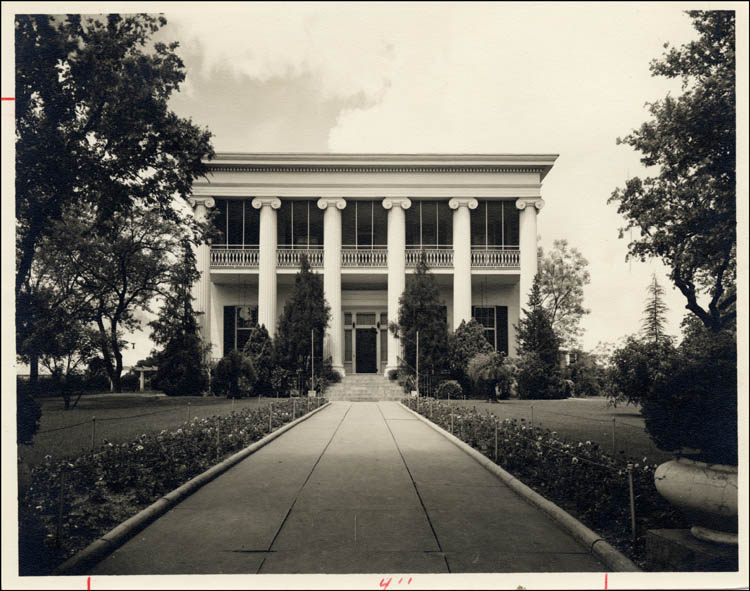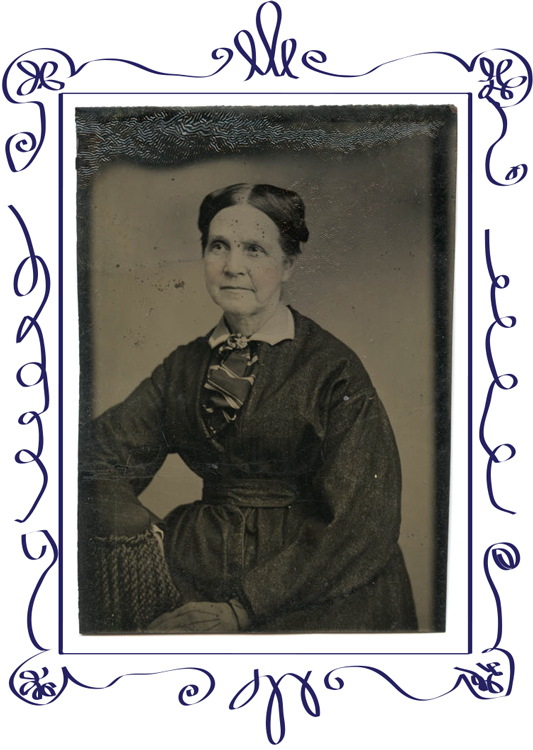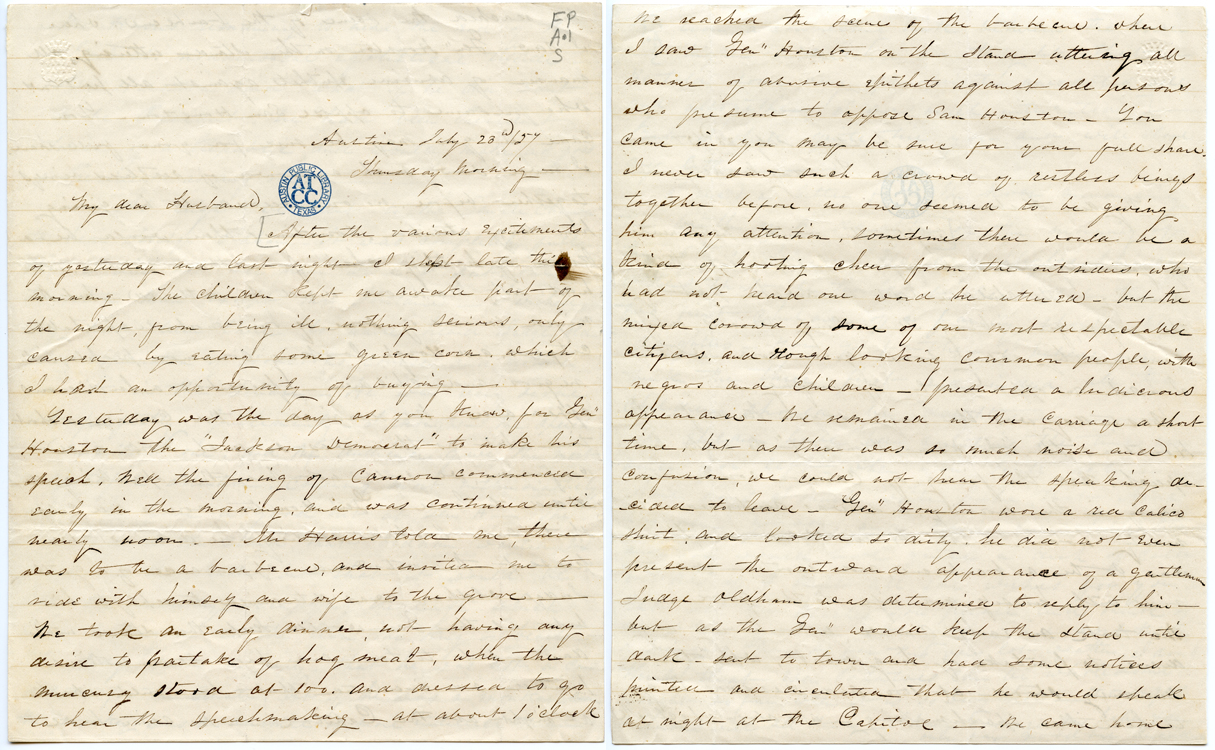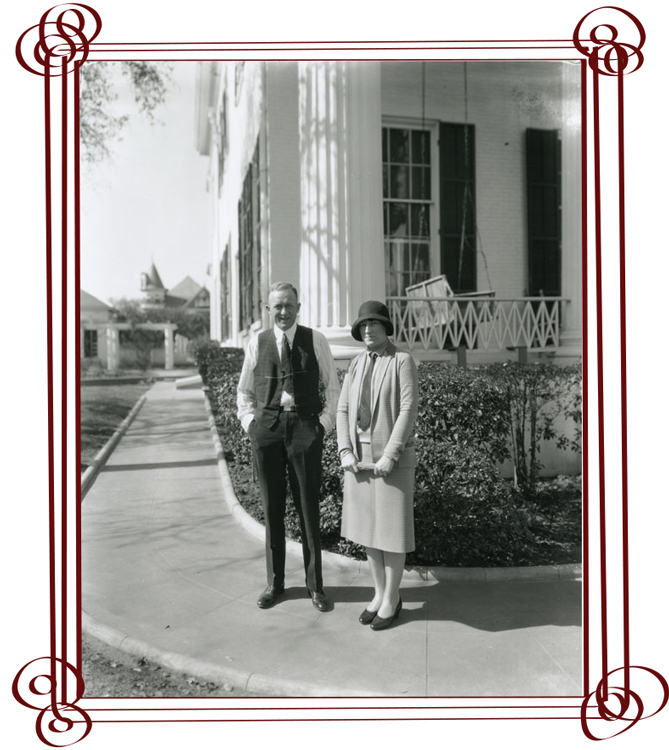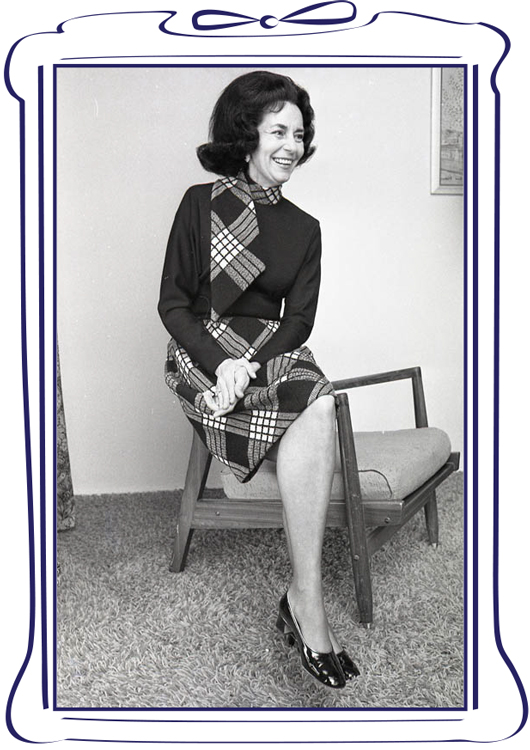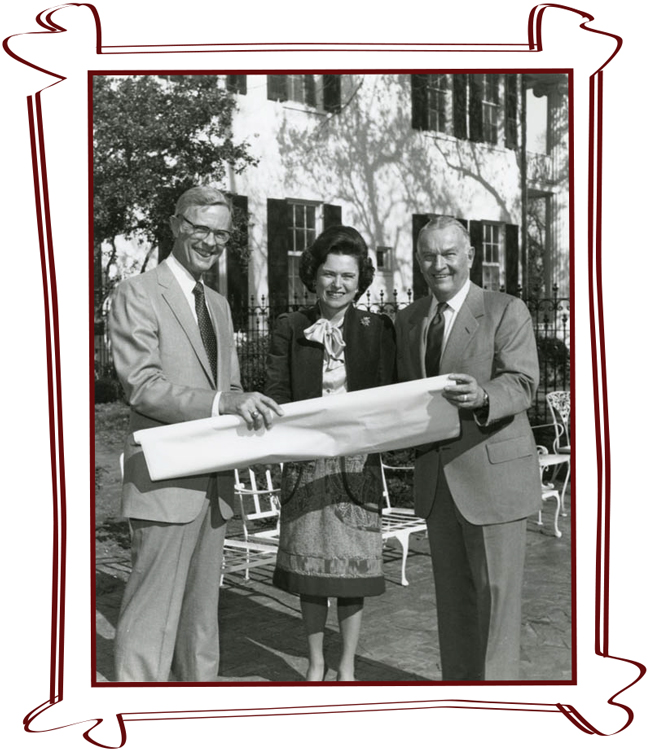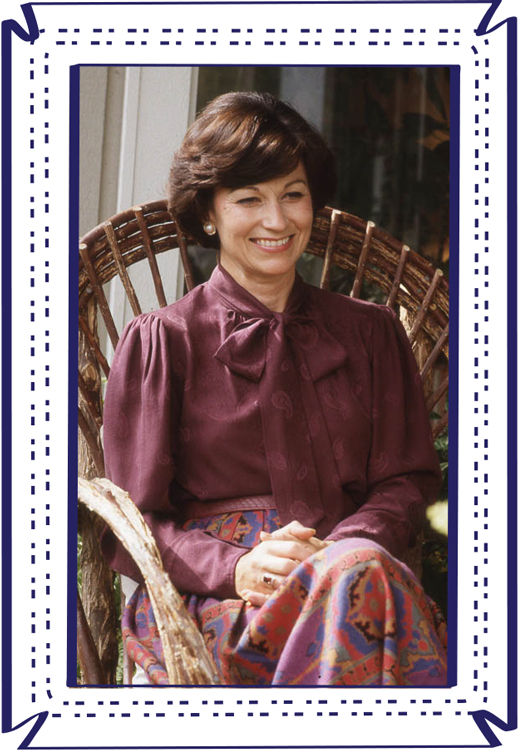Ladies of the Club: Texas' First Ladies
| Since there have only been two female governors in Texas, there have been many first ladies. With the Governor’s Mansion in town, Austin has been home to many of them. Many first ladies have played the role as supportive wife and have steered clear of politics. Others have been more mindful of their prominence, and though not elected to office, these women have used their position as a supporting player to support causes important to them. |
[Governor's Mansion], May 1, 1941, PICA 06559 |
[Lucadia Pease, hand-painted tintype portrait], circa 1860s, PICB 06782 | Lucadia Christiana Niles Pease
Lucadia was wife of Governor Elisha Marshall Pease whose three terms in office spanned 1853-1857 and 1867-1869. The Peases were the first family to inhabit the Governor’s Mansion, which had been designed by Abner Cook and built on a location chosen by the Peases. After many building delays, the Peases moved in in June 1856. Originally from Connecticut, Lucadia corresponded often with her distant family and with her husband when she was traveling to visit family or when he was traveling on business. These letters reveal much about life in early Austin. They also show that Lucadia took a real interest in and had opinions about political matters.
| |
A letter from Lucadia to her sisters dated February 27, 1854 describes how funds for the Governor’s Mansion were approved in 1854 and how expensive it was to establish a household at the time: We shall buy most of our furniture of Mrs. Ward, as we are only temporarily to remain here – the Legislature have appropriated, I may have written you, sufficient to build and furnish a house for the Gov[ernor] of the State and we hope they may be able to build it in about a year, that we may be benefitted by it. Furniture is most extravagantly dear here. We looked at the only cabinet wareroom, and for a common place bureau without a marble slab, the price was fifty dollars and everything in proportion… |
Letter. “Lu[cadia]” to “Sisters Ju[liet] and Augusta,” February 27, 1854, Pease-Graham-Niles Papers. AR.A.001. | |
In a letter to her husband while he was away from Austin dated July 23, 1857, Lucadia describes some of the political events he was missing. Of a speech by Samuel Houston she writes: I saw Gen. Houston on the stand uttering all manner of abusive epithets against all persons who presume to oppose Sam Houston—You came in you may be sure for your full share. I never saw such a crowd of restless beings together before, no one seemed to be giving him any attention, sometimes there would be a kind of hooting cheer from the outsiders, who had not heard one word he uttered. … Gen. Houston wore a red calico shirt, and looked so dirty, he did not even present the outward appearance of a gentleman. |
Letter. Lucadia to “My dear Husband [Elisha Marshall Pease],” July 23, 1857, Pease-Graham-Niles Papers. AR.A.001. |
Mildred Moody
Mildred Moody was wife to Governor Dan Moody. Originally from Abilene, Mildred studied at Simmons College in Abilene, received a Master’s in English from UT, and then completed a journalism degree at Columbia University. She taught and worked as a reporter and then married Dan Moody shortly before he became governor in 1927. His term lasted until 1931. As first lady, she determined that preservation measures were needed for the Governor’s Mansion. She oversaw some renovations and then convinced the 42nd Legislature to create a Board of Mansion Supervisors, which she headed until 1941. |
[Governor Dan Moody and First Lady Mildred in front of the Governor’s Mansion], 1928, C02801, Chalberg Collection of Prints and Negatives |
Mrs. Dolph Briscoe, January 9, 1973, AS-73-83152-10, Austin American-Statesman Negative Collection. Photograph by Tom Lankes. | Janey Slaughter Briscoe
Janey Briscoe was married to Governor Dolph Briscoe, who was in office from 1973 to 1979. Though born in Missouri, she was raised in Austin and earned a degree in education from UT. As first lady, she had the Governor’s Mansion designated as a National Historic Landmark. She was also devoted to social services and special education. She worked with the Department of Mental Health and Mental Retardation to develop programs to provide work for the handicapped, and she created the state’s runaway hotline. |
Rita Crocker Clements
Rita Clements was active in politics long before marrying Bill Clements, who was governor 1979-1983 and again 1987-1991. Rita Clements graduated from UT in 1953, and by 1958 she was chosen as a precinct chairman for Dallas County Republicans. She was on the board for the National Federation of Republican Women and was a delegate to the Republican National Convention in 1968. In the 1970s she served on the National Advisory Council for Economic Opportunity. During her first term as Texas’ first lady, she led a restoration project of the Governor’s Mansion, raising $3.5 million. During her second term she worked to promote Texas tourism. Since then she has served on many boards and supported civic organizations. She was inducted into the Texas Women’s Hall of Fame in 1996. |
[John Watson, Rita Clements, and Governor Clements with plans by Watson for the restoration of the Governor’s Mansion], circa 1979-1983, PICB 17930 |
Linda Gale White, November 10, 1982, AS-82-4150-102, Austin American-Statesman Negative Collection | Linda Gale White
Linda Gale White was first lady from 1983-1987 while her husband Mark White was governor. In 1964 she graduated from Baylor University and she worked as a teacher in Austin and Houston and later as a real estate agent. While her husband was in office, she was devoted to improving the state’s education system and working on children’s issues. She was instrumental in bringing to Texas Communities In Schools, an organization that provides mentoring and social services at schools to prevent students from dropping out. The group has grown from working in five Texas cities to being in 27 cities serving 875 schools. |
Lady Bird Johnson
Claudia Alta Taylor was born in 1912 in Karnack, Texas, and it was a childhood nursemaid who gave her the nickname “Lady Bird.” She graduated from Marshall High School, attended a junior college in Dallas, and eventually went on to study history and journalism at UT. She planned a career in journalism but then met and soon married Lyndon Baines Johnson in 1934. She helped finance his fledgling political career with an inheritance. He won a seat in the U.S. House of Representatives in 1937, and during the Second World War when he was enlisted in the Navy, Lady Bird ran his congressional office. In 1943 Lady Bird invested in a radio station in Austin forming LBJ Holding Co., for which she served as president. The radio and television stations that she bought eventually made the Johnsons millionaires. Johnson went on to win a seat in the U.S. Senate and then became Vice President under President Kennedy. Lady Bird took on a large role during the 1960 presidential campaign. A pregnant Jacqueline Kennedy was not able to travel so Lady Bird substituted for her and helped the ticket win seven Southern states. When Kennedy was assassinated in 1963, Lady Bird was at Johnson’s side while he was sworn in as President. Austin’s own First Lady of the U.S. did not settle for the status quo of the position. Lady Bird was the first to have a staff of her own, with fellow Texan Liz Carpenter working as her press secretary. She soon got to work on a capital beautification project to improve Washington, D.C. by planting millions of flowers. She was instrumental in passing the Highway Beautification Act of 1965, also called the “Lady Bird Bill.” She started a series of Women Doers Luncheons, helped promote the Civil Rights Act of 1964, and advocated for the Head Start program. |
[Lady Bird Johnson], 1968, PICB 17596
|
When the Johnsons returned to Texas, Lady Bird continued her service work, focusing her efforts on Austin. As part of the Town Lake Beautification Project, she helped to plant trees and flowers and to create the hike and bike trails. The lake was eventually renamed in her honor. To celebrate her 70th birthday, Lady Bird donated land and funding to the city to start the National Wildflower Research Center.
She received the Medal of Freedom in 1977 and the Congressional Gold Medal in 1988. She died in 2007.
Click below to hear an excerpt from an oral history interview with Lady Bird conducted by Mike Cox on December 7, 1977. [Tape 2105]
